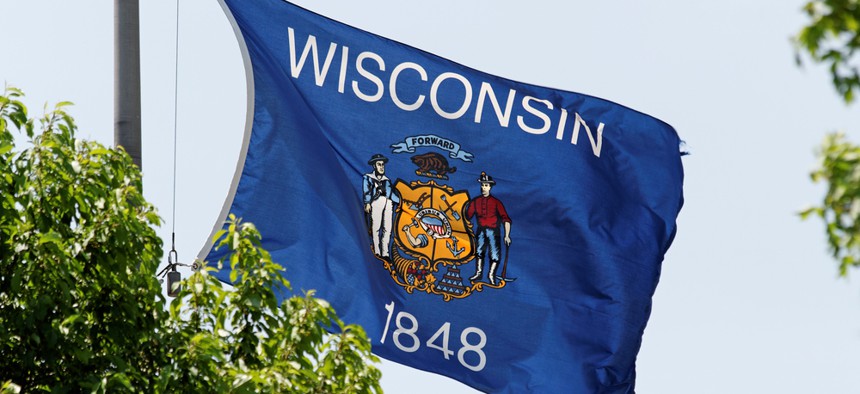Small Wisconsin Town vs. the Zen Butcher

Katherine Welles / Shutterstock.com

Connecting state and local government leaders
Bartlett Durand wanted to bring animal slaughter out into the open. But his neighbors weren't on board.
The weekday-morning slaughter line at Black Earth Meats in Mount Horeb, Wisconsin, may have seemed at a visitor’s first glance to be a standard cattle slaughter: the bolt gun, the hum of electric meat saws whirring through flesh and bone, the blood pooling into puddles and swirling toward drains in the center of a sloped concrete floor.
But a few moments of observation would have made the differences plain. First, there were typically far fewer animals than an industrial slaughterhouse—only about 45 head of cattle or 100 hogs per day. Usually, there were just eight workers along the line and very little machinery—no trace of the industrial chain-and-rail system that's used to speed up slaughter.
One of the most significant differences, though, was an easy one to overlook: the sign that hung high on the wall, out of the reach of blood splatter, which read, “We Honor These Animals, For By Their Death, We Gain Life.”
This was the house of the Zen Butcher.
Over the last seven years, a vibrant local foods community grew up around Black Earth Meats, Bartlett Durand's humane-handling slaughterhouse. The slaughterhouse and retail store developed an enormous following, supplied high-end restaurants all over the Midwest, supported nearly 50 employees and 200 area farmers, opened a Madison retail location called The Conscious Carnivore, and garnered attention from the Food Network’s Andrew Zimmern.
But on July 22nd, Black Earth Meats made its final slaughter and closed its doors. Durand’s goal was to make slaughter into something public, something people witnessed; that openness became the business’s downfall.
What happened?
* * *
Seven years ago, Bartlett Durand, a Buddhist and former vegetarian, was working with his father-in-law, Gary Zimmer, to run Otter Creek Organics, a diversified dairy farm. Otter Creek’s pastured beef and pork were in high demand, so Durand and Zimmer relied heavily on a local meat-slaughter-and-processing plant to supplement. The location had been a butchery, meat locker, and slaughter facility for decades, but the dwindling interest in freezer meat and the rise of supermarket butcher operations meant the then-owner of the plant was struggling to get enough customers to keep a steady crew running the butchery operation, let alone make a profit.
When the current owner let Durand and Zimmer know his finances were forcing him to close the business, they decided to go for it. With the help of Mary Ann Litchfield, a sustainable organic farmer and investor, they purchased the butcher shop and began building their own meat-processing business.
Durand and Zimmer’s vision was both progressive and a throwback, an homage to the history of farming in the region with a modern-day spin. Locker plants, which provide both butchery services for local farmers and freezer storage for customers, were once ubiquitous in the region, and Durand wanted to rebuild a local-food economy around this important point in the supply chain: to give farmers a source of reliable processing, and a chance to grow their herds knowing there was a steady buyer, all while providing restaurants and customers with high-quality meat.
But he also wanted this locker plant to be different. The modern slaughterhouse, Durand knew, is designed around the factory model, wherein speed and efficiency are paramount. Instead, Durand wanted his slaughtering facility to focus on attending to and honoring the significance of the animal’s life and the human’s work in taking that life.
He designed the processing facility with minimal industrial equipment, and to operate only on a scale small enough to accommodate a slower, more mindful rate of slaughter. Even from the moment of their arrival, the animals would be treated calmly and with kindness: The facility used a series of gates and chutes designed to move the animals gently through the process without the use of prods, minimizing fear and stress. The employees learned to keep quiet, move slowly, and position themselves so their very presence helped guide the animal along the slaughter line.
In addition to his focus on reducing the stress of the animals, Durand worked to develop the skills of a group of eight butchers who could handle the entire animal, as he says, “from stunning to steaks,” and training them in what he called “the philosophy of sacrifice.” The butchers were taught that when engaged in taking a life, they were doing so with purpose, for the good of the community. Respect for the animal at the moment of its death, Durand said, “must include the respect of the butcher, for in the butchers’ hands is the act of life and death, the moment of sacrifice, and that is one that cannot be taken lightly.”




